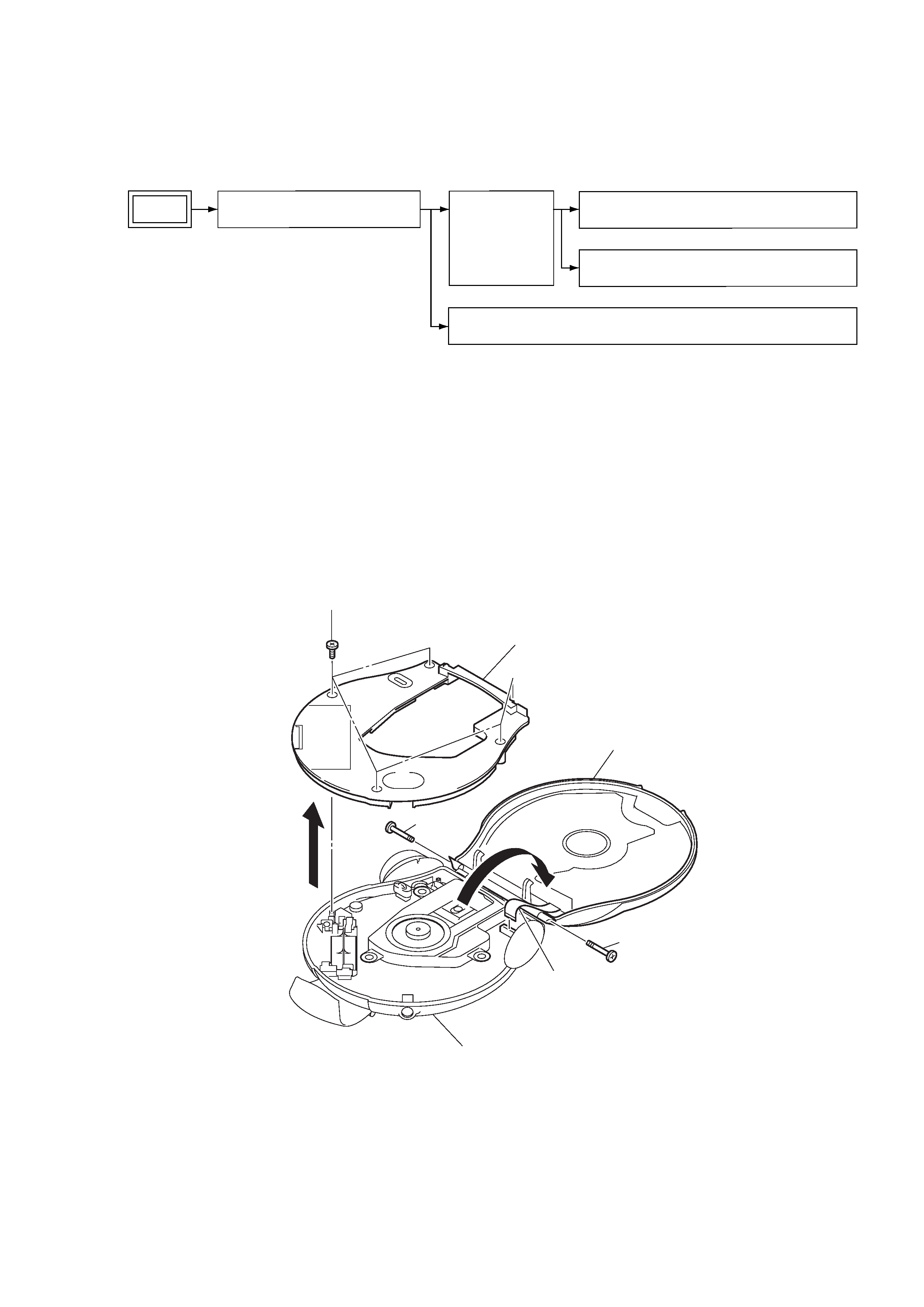
D-CS901
US Model
Canadian Model
AEP Model
UK Model
SERVICE MANUAL
PORTABLE CD PLAYER
Sony Corporation
Personal Audio Company
Published by Sony Engineering Corporation
9-874-052-01
2002F1600-1
© 2002.06
SPECIFICATIONS
Ver 1.0 2002. 06
Model Name Using Similar Mechanism
D-SJ301
CD Mechanism Type
CDM-3125ER
Optical Pick-up Name
DAX-25E
System
Compact disc digital audio system
Laser diode properties
Material: GaAlAs
Wavelength:
= 780 nm
Emission duration: Continuous
Laser output: Less than 44.6
µW
(This output is the value measured at a distance
of 200 mm from the objective lens surface on
the optical pick-up block with 7 mm aperture.)
D-A conversion
1-bit quartz time-axis control
Frequency response
20 - 20 000 Hz
0
dB (measured by JEITA CP-
307)
Output (at 4.5 V input level)
Headphones (stereo minijack)
Approx. 5 mW + Approx. 5 mW at 16
Power requirements
For the area code of the model you
purchased, check the upper left side of the
bar code on the package.
· Sony NH-WM2AA rechargeable batteries:
2.4 V DC
·Two LR6 (size AA) batteries: 3 V DC
·AC power adaptor (DC IN 4.5 V jack):
U2/CA2 model: 120 V, 60 Hz
CED model: 220 - 230 V, 50/60 Hz
CEK model: 230 - 240 V, 50 Hz
Battery life* (approx. hours)
(When you use the CD player on a flat and stable
surface.)
Playing time varies depending on how the CD
player is used.
Figures in brackets show the playing time of
MP3 files.
When using
G-PROTECTION function
"1"
"2"
NH-WM2AA
22
23
(charged for
[16]
[16]
about 5 hours**)
Two Sony alkaline
37
38
batteries LR6 (SG)
[24]
[24]
(produced in Japan)
* Measured value by the standard of JEITA (Japan
Electronics and Information Technology
Industries Association).
** Charging time varies depending on how the
rechargeable battery is used.
Operating temperature
· Abbreviation
5
°C - 35°C (41°F - 95°F)
Dimensions (w/h/d) (including
projecting parts and controls)
Approx. 134.1
× 38.5 × 147.8 mm
(5 1/4
× 1 1/2 × 5 7/8 in.)
Mass (excluding accessories)
Approx. 321 g (11.4 oz.)
Design and specifications are subject to change
without notice.
U2
: US model
CA2
: Canadian model
CED
: AEP model
CEK
: UK model
4.5
Supplied accessories
For the area code of the location in which you
purchased the CD player, check the upper left side
of the bar code on the package.
AC power adaptor (1)
Headphones/earphones (1)
Hand strap (1)

2
D-CS901
Flexible Circuit Board Repairing
·Keep the temperature of the soldering iron around 270 °C dur-
ing repairing.
· Do not touch the soldering iron on the same conductor of the
circuit board (within 3 times).
· Be careful not to apply force on the conductor when soldering
or unsoldering.
Notes on chip component replacement
·Never reuse a disconnected chip component.
· Notice that the minus side of a tantalum capacitor may be dam-
aged by heat.
This appliance is classified as a CLASS 1 LASER product.
The CLASS 1 LASER PRODUCT MARKING is located on
the rear exterior.
CAUTION
Use of controls or adjustments or performance of procedures
other than those specified herein may result in hazardous
radiation exposure.
On AC poweradaptor
·Use only the AC power adaptor supplied or
recommended in "Accessories (supplied/
optional)." Do not use any other AC power
adaptor. It may cause a malfunction.
Polarity of the plug
TABLE OF CONTENTS
SAFETY-RELATED COMPONENT WARNING!!
COMPONENTS IDENTIFIED BY MARK 0 OR DOTTED LINE WITH
MARK 0 ON THE SCHEMATIC DIAGRAMS AND IN THE PARTS
LIST ARE CRITICAL TO SAFE OPERATION. REPLACE THESE
COMPONENTS WITH SONY PARTS WHOSE PART NUMBERS
APPEAR AS SHOWN IN THIS MANUAL OR IN SUPPLEMENTS
PUBLISHED BY SONY.
ATTENTION AU COMPOSANT AYANT RAPPORT
À LA SÉCURITÉ!
LES COMPOSANTS IDENTIFÉS PAR UNE MARQUE 0 SUR LES
DIAGRAMMES SCHÉMATIQUES ET LA LISTE DES PIÈCES SONT
CRITIQUES POUR LA SÉCURITÉ DE FONCTIONNEMENT. NE
REMPLACER CES COMPOSANTS QUE PAR DES PIÈSES SONY
DONT LES NUMÉROS SONT DONNÉS DANS CE MANUEL OU
DANS LES SUPPÉMENTS PUBLIÉS PAR SONY.
1. SERVICING NOTE ·························································· 3
2. GENERAL ·········································································· 4
3. DISASSEMBLY ································································ 5
3-1. Lid Upper, Cabinet (Front) ············································ 5
3-2. MD Assy (CDM-3125ER), MAIN Board ····················· 6
3-3. Motor Assy, Turn Table (Spindle) (M901) ···················· 6
3-4. Motor Assy (Sled) (M902),
Optical Pick-up (DAX-25E) ·········································· 7
3-5. MAIN (SWITCH UNIT) Board, Hold Lever ················ 7
4. TEST MODE ······································································ 8
5. ELECTRICAL ADJUSTMENTS ······························· 11
6. DIAGRAMS ······································································ 12
6-1. Block Diagrams ··························································· 13
6-2. Printed Wiring Board MAIN Board (Side A) ······· 15
6-3. Printed Wiring Board MAIN Board (Side B) ······· 16
6-4. Schematic Diagram MAIN Board (1/4) ··············· 17
6-5. Schematic Diagram MAIN Board (2/4) ··············· 18
6-6. Schematic Diagram MAIN Board (3/4) ··············· 19
6-7. Schematic Diagram MAIN Board (4/4) ··············· 20
6-8. Printed Wiring Board
MAIN (SWITCH UNIT) Board ···························· 21
6-9. Schematic Diagram
MAIN (SWITCH UNIT) Board ···························· 22
6-10. IC Pin Function Descriptions ······································ 24
7. EXPLODED VIEWS ······················································ 33
6-1. Upper Lid Section ······················································· 33
6-2. Cabinet Section ··························································· 34
6-3. Cabinet Lower Section ················································ 35
6-4. Optical Pick-up Section (CDM-3125ER) ···················· 36
8. ELECTRICAL PARTS LIST ······································· 37

3
D-CS901
SECTION 1
SERVICING NOTE
The laser diode in the optical pick-up block may suffer electrostatic
breakdown because of the potential difference generated by the
charged electrostatic load, etc. on clothing and the human body.
During repair, pay attention to electrostatic breakdown and also use
the procedure in the printed matter which is included in the repair
parts.
The flexible board is easily damaged and should be handled with
care.
NOTES ON LASER DIODE EMISSION CHECK
The laser beam on this model is concentrated so as to be focused on
the disc reflective surface by the objective lens in the optical pick-
up block. Therefore, when checking the laser diode emission,
observe from more than 30 cm away from the objective lens.
BEFORE REPLACING THE OPTICAL PICK-UP BLOCK
Please be sure to check thoroughly the parameters as par the "Optical
Pick-Up Block Checking Procedures" (Part No.: 9-960-027-11)
issued separately before replacing the optical pick-up block.
Note and specifications required to check are given below.
· FOK output: IC601 yg pin
When checking FOK, remove the lead wire to disc motor.
· RF signal P-to-P value: 0.4 to 0.65 Vp-p
LASER DIODE CHECK
During normal operation of the equipment, emission of the laser
diode is prohibited unless the upper lid is closed while turning ON
the S801. (push switch type)
The following checking method for the laser diode is operable.
· Method:
Emission of the laser diode is visually checked.
1. Open the upper lid.
2. Push the S801 as shown in Fig. 1.
3. Check the object lens for confirming normal emission of the
laser diode. If not emitting, there is a trouble in the automatic
power control circuit or the optical pick-up. During normal
operation, the laser diode is turned ON about 2.5 seconds for
focus searching.
NOTES ON HANDLING THE OPTICAL PICK-UP
BLOCK OR BASE UNIT
Fig. 1 Method to push the S801
S801

4
D-CS901
SECTION 2
GENERAL
This section is extracted
from instruction manual.
Locating the controls
For details, see pages in parentheses.
CD player (front)
q; i (headphones)
jack
(pages 6, 21)
7 PLAY MODE
button
(pages 11 - 15)
4 DC IN 4.5 V
(external power
input) jack
(pages 6, 22)
6 FOLDER /+ buttons
(pages 9, 14)
2 3-way control key
(see below)
1 HOLD switch
(page 19)
3 VOL* (volume)
control
(page 7)
qa Buckle
(page 6)
5 Display
(pages 8, 9, 12 - 14, 16, 18, 19)
8 REPEAT/ENTER
button
(pages 11, 12, 14, 15)
9 SOUND button
(pages 18, 19)
qs DISPLAY button
(pages 16, 17)
2 3-way control key
Push toward
N
/> or
.
.
Press x/CHG.
N/>**: Play/AMS/search
(pages 7 - 9, 14)
.: AMS/search (pages 7, 14)
x/CHG: Stop/charge
(pages 7, 20, 22)
*There is a tactile dot beside VOL to show the direction to turn up the volume.
** There is a tactile dot beside N/>.
CD player (inside)
qf Battery compartment
(page 22)
qd G-PROTECTION
switch
(page 16)

5
D-CS901
SECTION 3
DISASSEMBLY
Note :
This set can be disassembled in the order shown below.
3-1. Lid Upper, Cabinet (Front)
Note :
Follow the disassembly procedure in the numerical order given.
SET
MOTOR ASSY (SLED)(M902),
OPTICAL PICK-UP (DAX-25E)
MAIN BOARD
MAIN (SWITCH UNIT) BOARD, HOLD LEVER
LID UPPER, CABINET (FRONT)
MD ASSY
(CDM-3125ER),
MOTOR ASSY, TURN TABLE (SPINDLE)(M901)
3
five screws (B2)
1
screw
6
flexible cable (20P)
1
screw
7
lid, upper
5
cabinet (front)
4
2
cabinet (lower) sub assy
